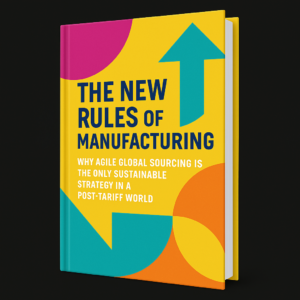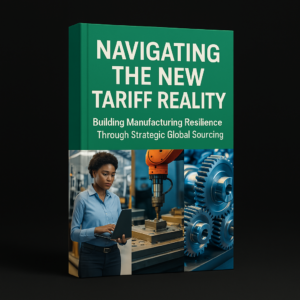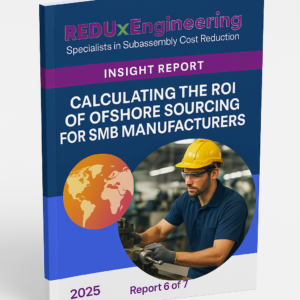Introduction: No Putting the Genie Back in the Bottle
When the White House announced its latest round of tariffs on April 2nd, many U.S. manufacturers were still holding out hope that this was temporary—that the political pendulum would swing back, restoring the global status quo. That hope is now a liability.
Tariffs are no longer a tool of negotiation; they have become embedded economic policy. As former U.S. Trade Representative Robert Lighthizer observed, “The age of free trade is over. The world is fragmenting into blocks, and companies need to adapt or perish.”
This isn’t just political theatre—it’s a structural transformation in global trade. And for small to medium-sized manufacturers in the tech and hardgoods sectors, the implications are clear: supply chain resilience, not cost optimization alone, is the new competitive frontier.
The Data Doesn’t Lie: Why Offshore Sourcing Still Wins
Despite the dramatic rhetoric around reshoring, the economic fundamentals continue to favor strategic offshore sourcing—particularly when guided by design, engineering, and managed execution. Let’s examine why.
Labor Cost Realities
The fully loaded cost of manufacturing labor per hour in 2025 is:
-
Vietnam: $6
-
India: $7
-
China: $15
-
United States: $77 to $115 (when adjusted for full labor burden, overhead, and capex)
(Source: U.S. Bureau of Labor Statistics, McKinsey & Co., REDUxEngineering internal audit data)
That’s a 4–11x cost gap. No tariff can sustainably close that.
Parts & Material Costs
Hardgoods manufacturers in the U.S. face an average of 30% higher raw material costs than those sourcing the same inputs from China or Southeast Asia. This disparity is compounded by continued inflation in domestic energy, logistics, and capital goods.
Manufacturing Infrastructure
China and Vietnam have spent decades building modern Industry 4.0 manufacturing ecosystems—robotic automation, lean lines, smart factories. Apple’s recent $500B U.S. investment announcement underscores the gap: that’s how much it takes just to begin catching up. And it’s still 10–20 years away from parity.
As Harvard Business School’s Willy Shih notes, “Once manufacturing ecosystems are lost, they’re incredibly difficult to rebuild. You lose not just factories, but skills, supplier networks, and innovation capacity.”
The Tariff Turmoil: Strategic Responses We’re Seeing Now
Across REDUxEngineering’s portfolio of global clients and partners, five dominant strategies are emerging:
-
Diversification Beyond China
Companies heavily dependent on Chinese sourcing are shifting aggressively to Vietnam, India, and Eastern Europe. This isn’t about cost alone—it’s about geopolitical risk, supply continuity, and tariff mitigation. -
Hybrid Assembly Models for U.S. Imports
Exporters into the U.S. are reducing the China content of their goods to below 49%, performing final assembly in lower-tariff countries like Mexico, Malaysia, or the Philippines. This qualifies them for lower duties while preserving offshore cost advantages. -
Drop-Ship Strategies for Global Sales
U.S. manufacturers with international customers are moving production offshore and shipping directly to avoid reciprocal tariffs in foreign markets—a rising concern with current EU and UK trade policies. -
Reshoring—But at What Cost?
Reshoring into the U.S. is constrained by limited capacity. As demand spikes, so do contract manufacturing rates—alongside lead times and quality concerns. As the Boston Consulting Group recently noted, “Reshoring is a mirage without massive capital and long timelines.” -
SMBs Face a Double Squeeze
Smaller U.S. manufacturers that traditionally sourced subassemblies domestically now face intense competition for shrinking capacity. Costs are rising. Lead times are slipping. Supplier performance is strained. And yet, the need for cost control and flexibility has never been greater.
A Global Playbook: Strategy for Western SMEs
For manufacturers in Canada, Western Europe, Australia, and New Zealand—where 10% U.S. import tariffs now apply across the board—there’s a straightforward equation at play:
-
Offshore sourcing generates 19%–49% savings on parts and subassemblies.
-
That offsets and exceeds the U.S. import tariff impact.
-
It creates a net margin gain on U.S. sales of 9%–39%—a powerful edge in competitive global tenders.
As Pascal Lamy, former WTO Director-General, recently emphasized, “The next wave of globalization will be selective, strategic, and digitally enabled. Success will go to those who combine smart sourcing with resilience.”
What the Numbers Say: Comparative Cost Model
| Sourcing Location | Avg. Labor Cost (Fully Loaded) | Material Cost Premium (vs. Offshore) | Projected Gross Margin |
|---|---|---|---|
| USA | $77–$115/hr | +30% | 0–33% |
| China | $15/hr | Baseline | 33–49% |
| Vietnam | $6/hr | Baseline | 40–55% |
| Philippines | $8/hr | Baseline | 35–50% |
(Source: REDUxEngineering, World Bank, Deloitte 2025 Global Manufacturing Cost Index)
Strategic Solutions, Not Sourcing Headaches
This isn’t about shifting factories—it’s about transforming supply chains into dynamic, responsive, profit-focused ecosystems. That’s the role REDUxEngineering plays.
REDUx provides contingency-based, engineering-led offshore sourcing that de-risks global supply strategies for manufacturers of all sizes. Their platform includes:
-
Site-audited, pre-qualified global suppliers
-
Advanced engineering support (DFM, DFA, inspection, logistics)
-
Industry 4.0 manufacturing access without CapEx
-
Drop-ship enablement for tariff-optimized global fulfillment
-
No upfront cost until savings are delivered
Conclusion: A Call to Strategic Action
We are entering an era where flexibility will outperform scale, and strategic sourcing will outmaneuver legacy infrastructure.
Tariffs are here to stay. Domestic capacity will remain constrained. Costs will rise. Political cycles will continue to shift.
But for manufacturers willing to embrace agile global sourcing—with the right partner—there is not just a path forward, but a path to profitability, stability, and long-term advantage.
This genie isn’t going back in the bottle. The question is—how will your organization harness it?
Formal Bibliography
-
U.S. Bureau of Labor Statistics (2025). “Employment Situation Summary.”
-
Boston Consulting Group (2025). The Mirage of Reshoring: Cost, Capacity, and Competitiveness.
-
McKinsey & Company (2024). Resilient Operations: Rethinking Global Manufacturing.
-
Apple Newsroom (2025). “Apple Will Spend $500 Billion in the U.S. Over the Next Four Years.”
-
World Bank (2024). Manufacturing Cost Index by Country.
-
Deloitte (2025). Global Manufacturing Competitiveness Index.
-
Shih, W. (2023). Restoring American Competitiveness, Harvard Business Review.
-
Lighthizer, R. (2024). The Case for Economic Nationalism. Hoover Institution.
-
Lamy, P. (2025). “Selective Globalization: The Next Industrial Revolution.” Financial Times.
-
REDUxEngineering (2025). Company Overview and Capabilities. https://reduxengineering.com
#GlobalTrade #TariffStrategy #ManufacturingResilience #SupplyChainRisk #StrategicSourcing #SMBManufacturing #ChinaPlusOne #GlobalManufacturing #OffshoreSourcing #ReshoringReality #CostOptimization #Industry40 #GeopoliticalRisk #SmartSourcing #REDUxEngineering






